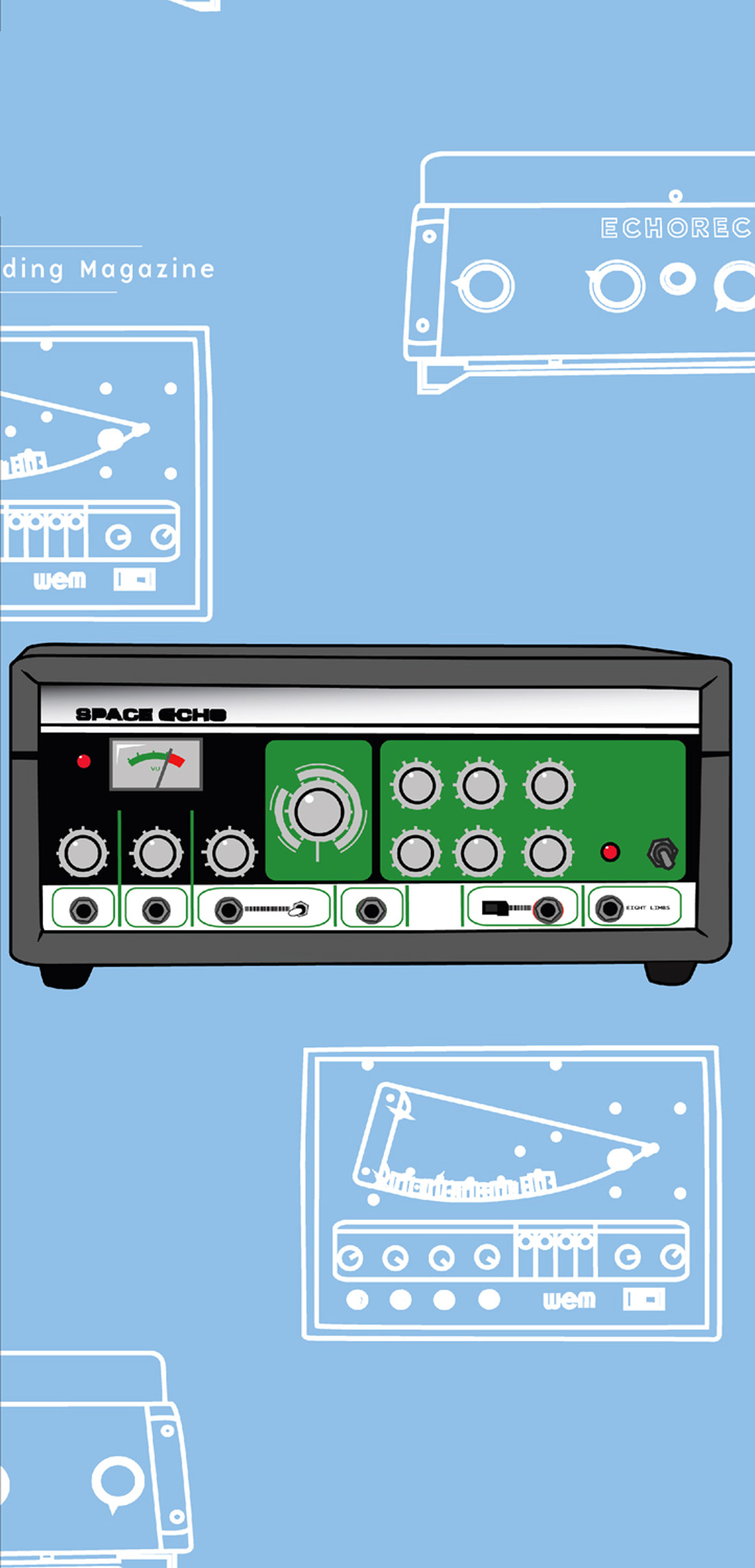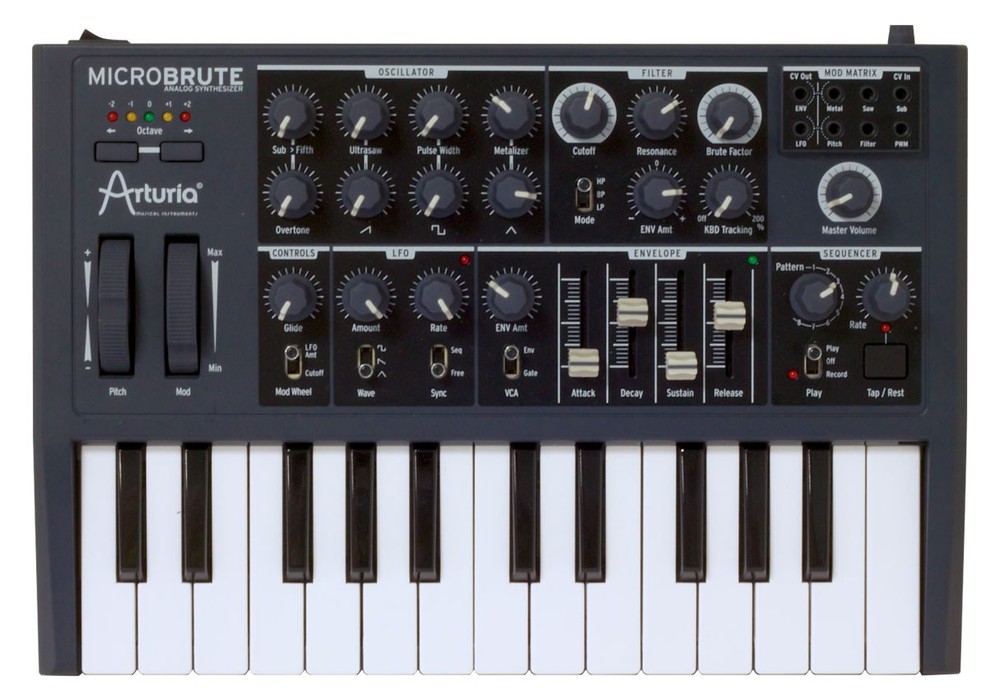I admit to having been quite skeptical when Eventide’s most recent stompbox, Space, arrived at my doorstep. In the first place, I’m the kind of guy whose favorite pedals have a maximum of three knobs. I generally have very little patience for any device with menu scrolling and multi-use rotary encoders. Also, I have just never heard really convincing reverb from a pedal, as much as I love pedals for other time-based effects like delay and chorus. To cut to the chase, despite my reservations, this is a powerful little box that is worth learning how to navigate.
There are ten — yes, ten — knobs on the face of Space, plus the aforementioned rotary encoder, and three very solid (yet not overly clicky) footswitches. There is also a small button for switching the box into Tempo mode, in which all time settings switch from milliseconds into divisions of a bar at the given tempo, indicated by the light flashing above the Tap footswitch. The other two switches are Active (programmable to bypass the unit in a few different ways) and HotSwitch, which is assignable to toggle any parameters between any two settings, effectively giving you double the amount of presets. ( Space stores up to 100 presets in its memory, all of which are user-writeable.) You can also switch Space into a mode where the two right-hand switches scroll up and down through your presets, if you like to change presets with your feet or palms instead of with your fingertips. The loaded preset/algorithm name or parameter you are affecting is displayed in big, bright, red LEDs, marquee-style, across the face of the pedal.
There is a virtual bevy of I/O on Space. Stereo unbalanced I/O is available, and there are switches for choosing line (–10 dBV) or instrument levels. (The pedal senses whether you are using mono or stereo I/O, and adjusts its internal routing accordingly.) There are two more 1/4’’ inputs, one for a standard expression pedal and one for up to three external switches in series, all of which can be assigned to control or change any parameters. There is also MIDI I/O, plus a USB port for connection directly to a computer for MIDI communication with DAWs as well as firmware updates and library management. The Factory Lib application is a free download from Eventide’s site, and although it looks and feels like it was written on System 7 for Mac 20 years ago, you can easily backup your patches, restore to factory settings, or remotely control your knob values from it. A PC version is available also. There’s even a super-killer Random button, which sets all of your parameters to — yes — random values, supporting Eventide’s clear commitment to achieving bizarre and unexpected sounds from their products.
The knobs themselves control different parameters based on the algorithm you have selected, but there is logic to what gets mapped where. The top left knob is always the Mix (or blend) control, and there is a global setting to have the value either always tied to the physical knob or to change to the saved value when you switch to a new preset. Other knobs are for standard things like decay time, pre-delay, and EQ, but also some left-field parameters like Wobble and Pitch Decay. I found the action of the knobs very smooth and responsive, although not quite analog-feeling. There is a slight cushion to the response, like you’re moving a medium-heavy object with a long, flexible stick. But never did I hear a digital artifact or click while changing a parameter, which makes the prospect of automating this dude quite enticing. Because, you see, that USB port that I mentioned above allows you to plug Space into your laptop (as I did) and within seconds be drawing in automation curves on MIDI tracks in your DAW (as I did), and mapping them to the various parameters of your active preset. Whoa. I think I just blew my own mind. You can also use Space’s controls to send MIDI messages to other gear, or sync up the MIDI clock between Space and other MIDI devices.
Hmm, I guess I should talk about the sound of the thing. Although I did use Space a few times as a guitar and bass stompbox, I’m gonna leave that review territory up to the guitar magazines and focus on the use of Space as an engineer’s tool in the studio. There are twelve underlying algorithms, upon which each of the presets is based, and all of which are descendant from Eventide’s legendary Harmonizer and Eclipse (Tape Op #31) effect machines. The straightforward reverb algorithms (Hall, Plate, Spring, and Room) are all shockingly useful for putting an instrument or vocal into an ambient space or creating a ‘verb halo around your source. DualVerb gives you two different reverbs, which can be combined in stereo or panned out into dual mono. Reverse, ModEchoVerb, BlackHole, TremoloVerb, and Shimmer all sound kinda like what you’d think they might (based on their names), but better. MangledVerb has a really interesting, useful, distorted reverb sound, and I consider myself somewhat of a distortion snob. DynaVerb was the most surprisingly noteworthy algorithm to me, as it combines a reverb with a model of Eventide’s unique Omnipressor dynamics box. This allows you to get incredible, richly dynamic ‘verbs, which can pulse with (or against) the tempo, get ducked by the signal coming in, or get into some crazy chaotic fluttery territory. I now realize how much more there is to be done using dynamic processing in conjunction with reverbs than I had ever thought possible. Thank you, Eventide.
One of my very few, very small complaints is that Space comes so chock full of cool presets, in order to save one of your own, you have to overwrite a factory preset. Also, sometimes it’s easy to accidentally switch to a new preset with the rotary encoder, and lose your unsaved sound you’ve been toiling over. (Luckily it’s also easy to save your sounds and to restore factory presets.) Overall, with an extremely sturdy build, top-notch sound, an abundance of I/O, external control options, and a relatively straightforward interface (although you’ll definitely need the manual handy for a while), Space gets my absolute highest marks for a stompbox/tabletop reverb unit — or for any time-based hardware effect box at this price point, for that matter. It was really smart of Eventide to put stereo line-level I/O on Space (although I wish it were balanced +4 dBu instead of unbalanced –10 dBV), and as such, it will see a lot of use in my studio. It’s also small and light enough to throw into a bag for easy integration into a traveling live-sound setup. (If you come see tUnE-yArDs play anywhere this winter or spring, for instance, I expect I will be using it on Merrill’s vocal.) My compliments to Eventide — an incredible amount of thought went into the design of Space; almost every time I thought I had found something I didn’t like about the pedal, I realized there was a way to change the settings to make it do what I wanted it to. All in all, this is a quality product that I expect many people will love to use. ($499 street; www.eventide.com)
–Eli Crews, www.elicrews.com
Dynamics, Effects, Interfaces, Signal Processors | No. 24
FATSO Jr model EL-7
by Andy Hong
FATSO is an acronym for Full Analog Tape Simulator and Optimizer. When digital multitracking first became affordable, it took only one session using 16 tracks of ADAT to convince me that I didn't want...





_disp_horizontal_bw.jpg)